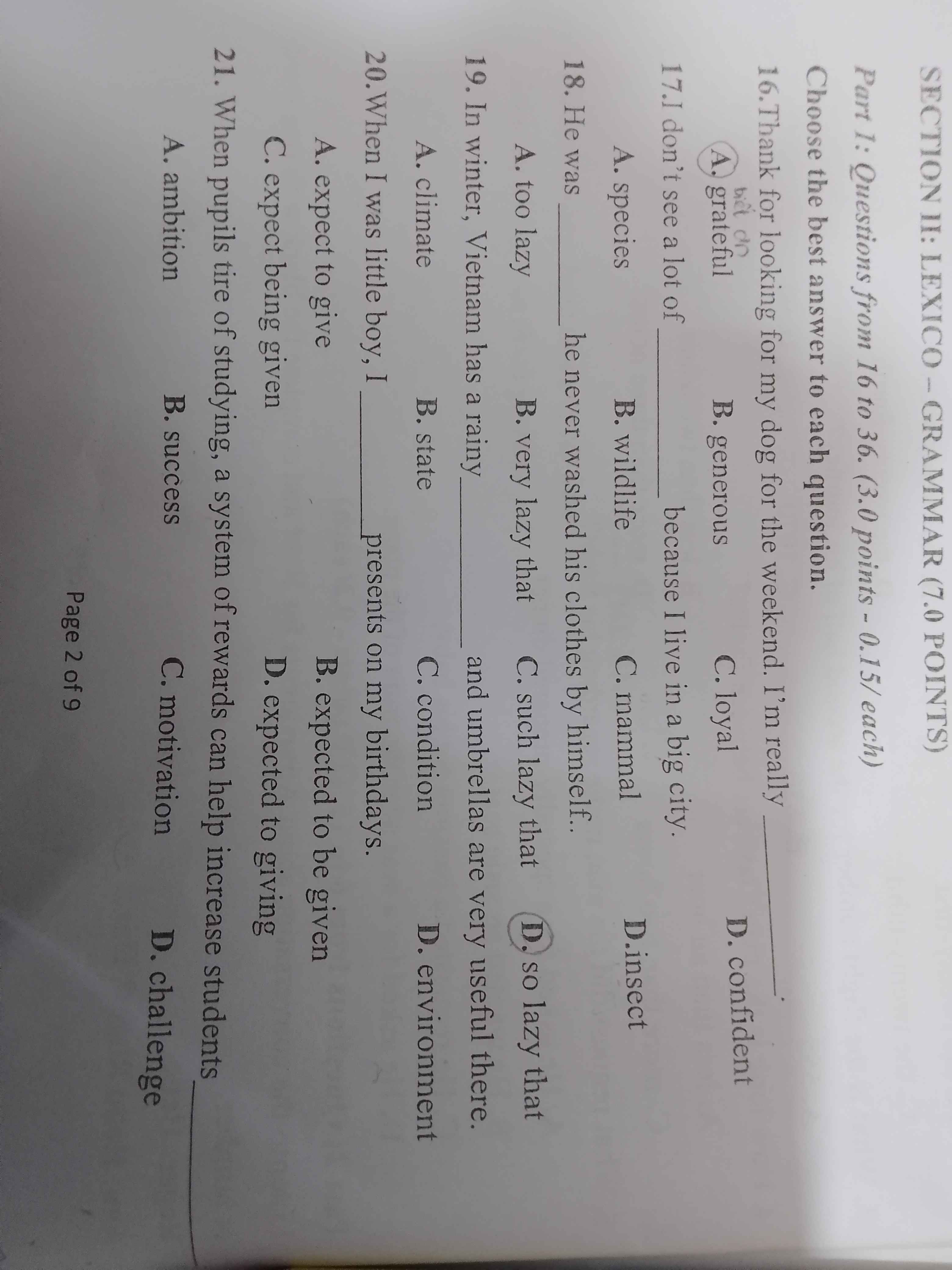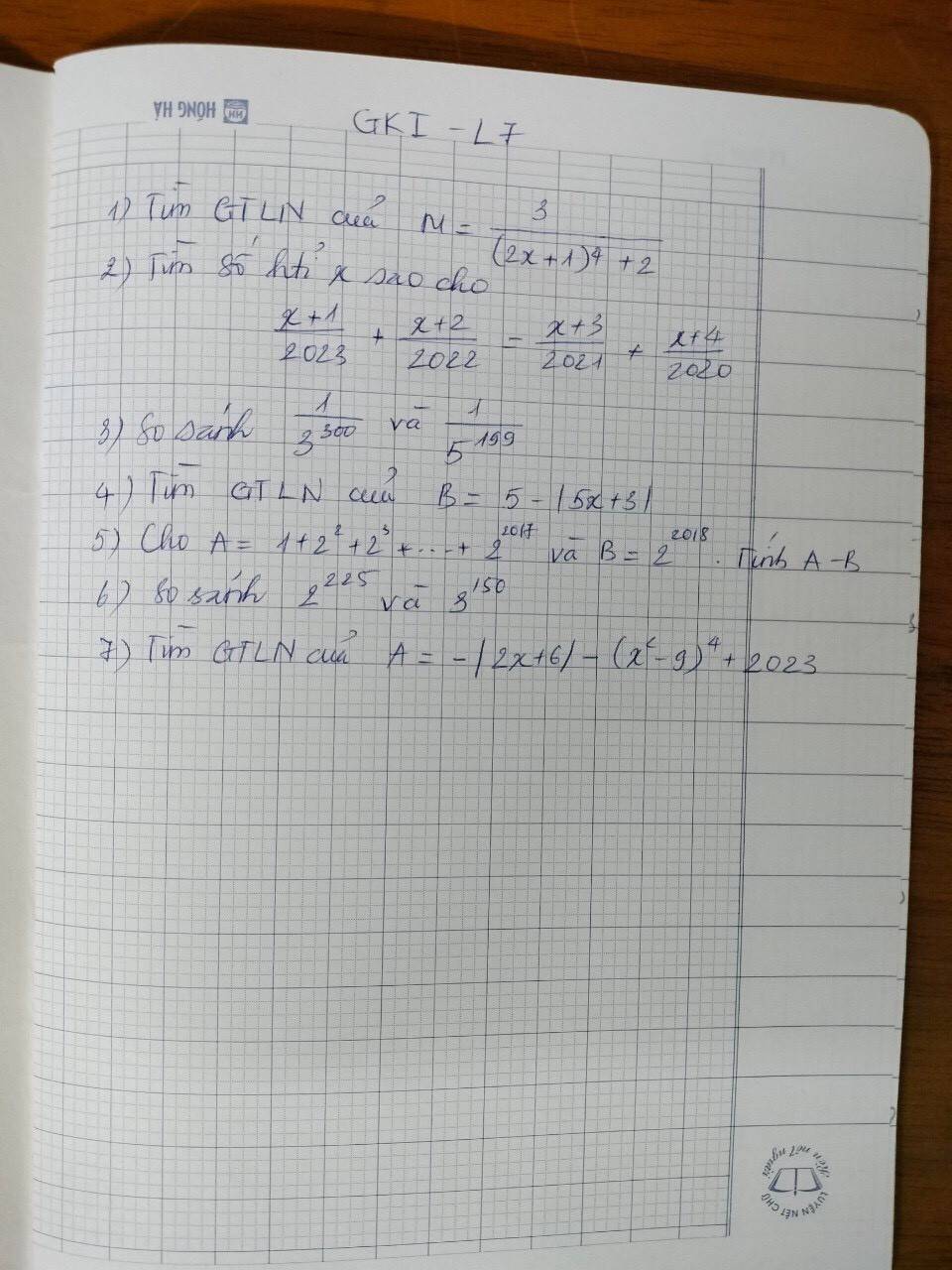 giúp với ạ
giúp với ạ
Hãy nhập câu hỏi của bạn vào đây, nếu là tài khoản VIP, bạn sẽ được ưu tiên trả lời.



mở bài là giới thiệu về cụ nha mn em viết lộn ạ
thân bài là đóng góp ạ

PTHH : 2Al + 6HCl --> 2AlCl3 + 3H2 ↑ (1)
nAlCl3 = \(\dfrac{m}{M}=\dfrac{13,35}{27+35,5.3}=0.1\left(mol\right)\)
Từ (1) => nHCl = 2nH2 = 0.2 (mol)
=> mHCl = n.M = 0.2 x 36.5 = 7.3 (g)
\(PTHH:2Al+6HCl\rightarrow2AlCl_3+3H_2\\ n_{AlCl_3}=\dfrac{m}{M}=\dfrac{13,35}{133,5}=0,1\left(mol\right)\\ Theo.PTHH:n_{HCl}=3.n_{AlCl_3}=3.0,1=0,3\left(mol\right)\\ m_{HCl}=n.M=0,3.36,5=10,95\left(g\right)\)

6:
\(2^{225}=\left(2^3\right)^{75}=8^{75}\)
\(3^{150}=\left(3^2\right)^{75}=9^{75}\)
mà 8<9
nên \(2^{225}< 3^{150}\)
4: \(\left|5x+3\right|>=0\forall x\)
=>\(-\left|5x+3\right|< =0\forall x\)
=>\(-\left|5x+3\right|+5< =5\forall x\)
Dấu = xảy ra khi 5x+3=0
=>x=-3/5
1:
\(\left(2x+1\right)^4>=0\)
=>\(\left(2x+1\right)^4+2>=2\)
=>\(M=\dfrac{3}{\left(2x+1\right)^4+2}< =\dfrac{3}{2}\)
Dấu = xảy ra khi 2x+1=0
=>x=-1/2

Ta có:
(2 - 3x)(x + 8) = (3x - 2)(3 - 5x)
⇔ (2 - 3x)(x + 8) - (3x - 2)(3 - 5x) = 0
⇔ (2 - 3x)(x + 8) + (2 - 3x)(3 - 5x) = 0
⇔ (2 - 3x)(x + 8 + 3 - 5x) = 0
⇔ (2 - 3x)(11 - 4x) = 0
⇔ 2 - 3x = 0 hay 11 - 4x = 0
⇔ 2 = 3x hay 11 = 4x
⇔ x = \(\dfrac{2}{3}\) hay x = \(\dfrac{11}{4}\)
Vậy tập nghiệm của pt S = \(\left\{\dfrac{2}{3};\dfrac{11}{4}\right\}\)
<=> (2-3x ) (x+8) + (2-3x ) (3-5x)=0
<=> (2-3x ) ( x+8 + 3-5x ) =0
<=> (2-3x ) ( 11 - 4x ) = 0
=> 2-3x =0 hoặc 11-4x =0
3x = 2 4x =11
x = 2/3 x = 11/4


Nguyên nhân dẫn đến sự hình thành thiên tai trước hết là do tính chất phân hóa theo không gian, thời gian của các yếu tố thời tiết thủy văn. Trong đó đáng chú ý nhất là các yếu tố mưa và dòng chảy. Sự chênh lệch lớn giữa hai mùa khô cạn và mưa lũ của hai yếu tố này làm cho mùa mưa thì thừa nước sinh lũ lụt, đến mùa khô lại chịu cảnh hạn hán, thiếu nước. Địa hình cũng góp phần đáng kể vào việc hình thành thiên tai. Hệ thống đồi núi nhấp nhô, đỉnh khá nhọn và cao nguyên bậc thềm xen kẽ làm cho địa hình phân cắt, hiểm trở, đi lại khó khăn, nhiều nơi độ dốc trên 10 độ. Đây là điều kiện thuận lợi cho việc rửa trôi, xói mòn, dồn nước nhanh chóng tạo nên những cơn lũ quét và những cơn lũ có biên độ lũ lớn, sườn lũ dốc, khó dự báo trước, gây thiệt hại đáng kể cho sản xuất, xây dựng, giao thông thủy lợi, có khi là cả tính mạng con người. Hoạt động của con người là một trong những nguyên nhân làm cho thiên tai có chiều hướng gia tăng và thêm nguy hiểm hơn. Tàn phá rừng tự nhiên đã làm mất cân bằng sinh thái nghiêm trọng. Nhiều vùng đất vốn xưa kia có cây rừng nay bị tàn phá trở nên cằn cỗi, không còn khả năng điều hòa dòng chảy làm cho dòng chảy lũ vốn đã nguy hiểm do độ dốc lớn nay lại thiếu sự che chắn của cây rừng nên càng trở nên nguy hiểm hơn. Không còn cây rừng thì chỉ sau khi kết thúc mưa một thời gian đất đai lại trở nên khô cằn, dòng chảy cạn kiệt.


 Ai giúp mình với ạ
Ai giúp mình với ạ

 giúp em với ạ em đang cần gấp ạ. Bài nào làm đc trc thì làm trc giúp em với ạ
giúp em với ạ em đang cần gấp ạ. Bài nào làm đc trc thì làm trc giúp em với ạ
\(200ml=0,2l\\ n_{Na_2SO_4}=0,2.0,1=0,02mol\\ a)Na_2SO_4+BaCl_2\rightarrow BaSO_4+2NaCl\)
0,02 0,02 0,02 0,04
\(b)m=m_{BaSO_4}=0,02.233=4,66g\\ c)50ml=0,05l\\ C_{M_{BaCl_2}}=\dfrac{0,02}{0,05}=0,4M\)